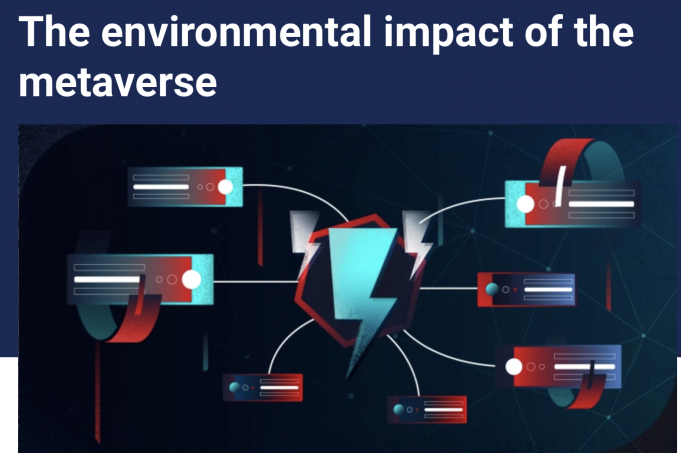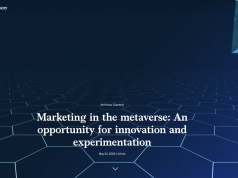Some companies believe that the metaverse — a yet-to-be-realized, internet-like series of connected worlds — has enormous potential in the enterprise. For example, it could be used to improve work productivity by allowing employees to train or collaborate in workplace-like virtual environments. Or it could host home and office tours, a boon for a real estate market contending with pandemic travel restrictions.
One source anticipates that the metaverse will be a $10 trillion to $30 trillion opportunity within the next 10 to 15 years. But this projection ignores a massive potential downside of the technology: its environmental impact. The datacenters required to run the metaverse’s persistent worlds aren’t cheap from an energy consumption standpoint. And at least one vendor, Intel, figures that a 1,000 times increase in power is needed over our current collective compute capacity to power the metaverse — which could grow its carbon footprint even further.UnmuteAdvanced SettingsFullscreenPauseUp NextData SummitWatch Full Session
Energy-hungry technologies
The technologies that’ll enable the metaverse of the future vary depending on whom you ask, but it’s commonly understood that virtual reality (VR), AI, and blockchain will play roles. Each can consume large amounts of power. For example, a 2020 Greening The Beast study estimated that high-end gamers, which have the hardware required for state-of-the-art VR, will spend as much as $2,200 over the course of five years on electricity and pump as much as 2,000 pounds of carbon emissions into the atmosphere each year.ADVERTISEMENT
The servers delivering the various elements of the metaverse are costlier still. While it’s difficult to know the environmental impact of every datacenter — many don’t report key metrics — one study posited that datacenters were responsible for about 2% of global greenhouse gas emissions in 2015, which is the same amount generated by the entire aviation industry. Notably, 2015 was before the advent of cloud gaming platforms like Google’s Stadia and Microsoft’s Xbox Cloud Gaming, which studies have shown to be highly compute-resource-intensive. In a 2016 paper, researchers at the Lawrence Berkeley National Laboratory found that the additional energy used in cloud gaming can cause annual electricity use to rise 40% to 60% for desktops, 120% to 300% for laptops, 30% to 200% for consoles, and 130% to 260% for streaming devices.
The findings were mirrored in a more recent study by researchers at the U.K.’s University of Bristol. It found that, if just 30% of gamers using 720p or 1080p devices were to transition to cloud gaming by 2030, it’d cause a 29.9% increase in carbon emissions. If 90% of gamers moved to the cloud, it’d increase gaming’s overall carbon emissions by 112%.
To mitigate latency and the other issues that come along with cloud connectivity, the type of VR rendering required for the metaverse is mostly done locally — at least today. But several companies are developing streaming platforms optimized for VR, akin to Nvidia’s GeForce Now. Google has endorsed Nvidia’s CloudXR technology running on its datecenters, which performs environment rendering in the cloud and streams it to any compatible VR headset. And Meta (formerly Facebook) CEO Mark Zuckerberg has said that he envisions Meta’s cloud gaming service being “useful for VR” down the line.
AI
Given the envisioned scale of the metaverse, AI has been proposed as a way to quickly fill the virtual worlds that inhabit it with content. Among others, Metaphysic — the startup behind the viral series of Tom Cruise deepfakes — aims to apply its technology to generate avatars, plants, animals, and inanimate objects that can be remixed by users to create custom experiences.ADVERTISEMENT
“There will be markets for trading AI models to generate new content, much like users can purchase custom in-game items today. The combination of AI-generated content and virtual reality will allow for total immersion in alternative realities,” Metaphysic writes in a blog post.
But these types of generative AI systems require a lot of compute power to train and run. Take OpenAI’s DALL-E, for example, which can craft an image given a text prompt. While OpenAI hasn’t detailed the compute requirements for DALL-E, the system is a scaled-down version of the text-writing AI system GPT-3trained on pairs of text and images from the internet. GPT-3 used 1,287 megawatts and produced 552 metric tons of carbon dioxide emissions during training — the same amount emitted by 100 average homes’ electricity usage over a year.
Nvidia’s StyleGAN3, which can be used to generate portraits of people that don’t exist, is similarly expensive to train. Nvidia reports that it consumes around the same amount of energy (225 megawatts) as tens of thousands of U.S. homes.
Aditya Ramesh, a researcher working on the DALL-E team, conceded in a recent interview with VentureBeat that the training process for generative models like DALL-E is “always going to be pretty long and relatively expensive” — especially if the goal is a single model with a diverse set of capabilities.
Blockchain
Some experts believe that blockchain technologies will — and perhaps already have — become essential to the metaverse. Among other applications, blockchain enables non-fungible tokens (NFTs) — unique pieces of data associated with photos, videos, audio, and other types of media. NFTs come in the form of avatars, artwork, music, digital creatures, and HTML code, as well as plots of land in virtual worlds like Decentraland and The Sandbox.ADVERTISEMENT
In one vision of the metaverse, users could use NFT avatars as a secure, authenticatable way to enter and hop between different worlds. Because blockchain technology makes NFTs practically impossible to forge, they could provide greater security than that afforded a traditional account.
But NFTs are notoriously expensive to produce. The reason is that the mechanism used to “mint” most NFTs — proof-of-work — relies on a computationally costly system called mining. Most NFT minters opt for the Ethereum blockchain, which requires computers — “miners” — to take turns guessing the answer to an increasingly challenging math problem. The miner that correctly guesses the answer wins a reward in Ether, a cryptocurrency, and a new math problem is generated.
One Cambridge University study suggested that global bitcoin mining, which is similarly proof-of-work, consumes more electricity annually than the entire country of Argentina.
Potential solutions
It’s worth noting that several companies have pledged to take steps to reduce the impact of their metaverse-powering datacenters on the environment. For example, Google has committed to operating on 24/7 carbon-free energy in all its datacenters by 2030. Microsoft intends to be “carbon negative” by 2030, which includes a plan to stop using diesel fuel in its datacenter generators by 2030. And Amazon Web Services (AWS) aims to power its operations with 100% renewable energy by 2025.ADVERTISEMENT
Advances in technology, too, could decrease the footprints of datacenters in the years to come. A 2020 analysis in the journal Joule found that, while the server, storage, and network workloads hosted by the cloud datacenters increased 2,600% from 2010 to 2018, energy consumption for all datacenters rose less than 10%. The coauthors attribute the inverse trend to a shift of workloads to bigger, more efficient server hardware.
On the local compute level, a range of approaches could be taken to reduce energy usage. A 2019 study in the Computer Games Journal found an average 13% energy savings potential for improving power supplies in gaming PCs. Underclocking, or reducing the speed of certain hardware components, subsequently reduced power use by up to 25%, the researchers said.
Software innovations could lead to efficiency gains, as well. For example, in recent years, foveated rendering has come into wider use, enabling VR engines to render fewer pixels in a headset wearer’s periphery while maintaining a high resolution in the center of vision. Tobii, a provider of eye-tracking technologies, including products that support foveated rendering, estimates that foveated rendering can reduce a key GPU workload by an average of 16% *
On the blockchain side, energy-efficient alternatives to proof-of-work are gaining attention. The next generation of Ethereum will move to proof-of-stake, which will allow cryptocurrency owners to stake their assets as collateral in order to validate transactions by consensus on the network. According to the Ethereum Foundation, the organization developing standards for the Ethereum blockchain, proof-of-stake will use roughly 99.95% less energy than the current standard.ADVERTISEMENT
Game developer Ubisoft plans to use a proof-of-stake blockchain, Tezos, for its forthcoming Quartz NFT platform. Ubisoft blockchain technical director Didier Genevois has been quoted as saying that one transaction on the Tezos network uses the same amount of energy as streaming 30 seconds of video, while the previous generation of blockchain networks can consume the same energy required for one year of non-stop streaming.
Beyond proof-of-stake, startups like StarkWare claim to have developed techniques that can reduce the carbon impact of Ethereum mining and transactions by packing more information into each block of the blockchain. “Layer 2” solutions like these let users make transactions outside the blockchain and then batch-process them at once in one big transaction, saving costs.
But as the Motley Fool noted in a recent piece, market demand will ultimately dictate the uptake of these more environmentally friendly technologies.
“If the market demands a more environmentally responsible way to buy, sell, and collect NFTs, the industry will deliver … But no other blockchain that supports smart contracts necessary for NFTs has the reliability and reputation of Ethereum,” The Motley Fool’s Adam Levy writes. “So, bigger NFTs … may still want to use the Ethereum blockchain. To that end, it’s on the Ethereum network to migrate to Ethereum 2.0 or develop a reliable layer 2 solutions for NFTs on the Ethereum blockchain.”
Looking ahead
The metaverse, even in its proof-of-concept phase, could contribute substantially to emissions. Truly detailed virtual environments will require more powerful — and potentially environmentally ‘unfriendly’ — infrastructure.ADVERTISEMENT
A combination of hardware, software, and protocol improvements could to combat the worst of the metaverse’s effects. Intel’s Raja Koduri believes that algorithmic solutions could lead to further gains in compute efficiency, in addition. But it’s not at all clear whether adopters of metaverse technologies will prioritize efficiency over scale — barring regulations that force change, like the rules under consideration by the European Union.
As evidenced by Bitcoin and other early blockchain protocols, growth sometimes comes first, creating problems that the community must scramble to reactively fix — if they’re sufficiently motivated to fix them in the first place. It wasn’t until relatively recently that the AI industry started taking a hard look at the environmental impacts of its increasingly large systems. The same may be true for companies investing in the metaverse — unless users demand better.
Of course, if the metaverse someday significantly eliminates the need for physical offices and commutes, the benefits could be worth the trade-offs. In the U.S., commercial buildings consume 35% of all of the country’s electricity and generate 826 million metric tons of carbon dioxide emissions each year. Commuting to those buildings takes the average American just under one hour each day and 32 miles by gas-powered car, equating to 3.2 tons of CO2 per person annually.
It’s not just car commutes that the metaverse promises to reduce — or eliminate. Flights are outsize polluters, responsible for about 11% of all transportation-related emissions in the U.S. A single round-trip flight between New York and California generates roughly 20% of the greenhouse gases that a car emits over an entire year.ADVERTISEMENT
The wastefulness of paper — which the metaverse would digitize — must be considered, too. It’s estimated that U.S offices use 12.1 trillion sheets of paper a year; paper accounts for 25% of landfill and 33% of municipal waste. One ton of copy paper — 400 reams — requires 11,341 kilowatt-hours of energy (the same amount of energy used by an average household in 10 months) and 5,869 pounds of greenhouse gases (the equivalent of six months of car exhaust) to produce.
But the calculus isn’t that simple. For example, research from WSP U.K. found that remote work in the U.K. may only be more environmentally friendly in the summer due to the need to heat individual workers’ buildings versus one office. This might not hold true in regions that derive energy from more sustainable sources, like Iceland, which uses a significant amount of geothermal power.
This much is clear: the metaverse will be costly. But more research must be done on whether the costs can — and will — be offset, and to what degree the impact will be distributed across geographies.









